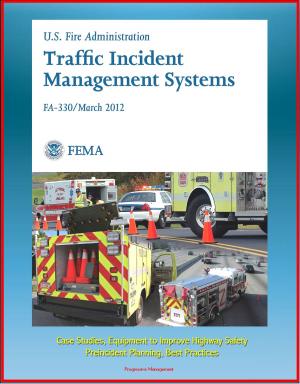The Valley Forge Encyclopedia: Comprehensive History of the Famous American Revolutionary War Winter Continental Army Encampment, Valley Forge Historical Research Report, Logistics, Cabins
Nonfiction, History, Revolutionary, Military, United States| Author: | Progressive Management | ISBN: | 9781301057641 |
| Publisher: | Progressive Management | Publication: | October 20, 2012 |
| Imprint: | Smashwords Edition | Language: | English |
| Author: | Progressive Management |
| ISBN: | 9781301057641 |
| Publisher: | Progressive Management |
| Publication: | October 20, 2012 |
| Imprint: | Smashwords Edition |
| Language: | English |
Discover the fascinating stories and unique history of the Valley Forge, Pennsylvania revolutionary war camp, now preserved as the Valley Forge National Historical Park. This impressive compilation provides a stunning, richly detailed overview of all aspects of the encampment, incorporating a complete reproduction of the milestone National Park Service Valley Forge Historical Research Report.
Contents: PART 1: Valley Forge Historical Research Report * Volume 1 - The Vortex of Small Fortune: The Continental Army at Valley Forge, 1777-1778 * Volume 2 - This Fatal Crisis: Logistics and the Continental Army at Valley Forge, 1777-1778 * Volume 3 - In The True Rustic Order: Historic Resource Study and Historical Base Maps of the Valley Forge Encampment 1777-1778 * PART 2 - The British Campaign for Philadelphia and the Occupation of Valley Forge in 1777 * PART 3 - Valley Forge History * PART 4 - Tolerably Comfortable: A Field Trial of a Recreated Soldier Cabin at Valley Forge
Research Report material: The Campaign For Pennsylvania * Starve, Dissolve, Or Disperse * Trublesum Times For Us All But Wors For The Solders * The Stone Which The Builders Have Rejected * The Lord's Time To Work * The Chapter Of Experiments * As The Fine Season Approaches * Abbreviation Key * The Commissary * Introduction * Qualifying Supply * The Eastern Department * Toward Valley Forge * The Sayins Of Solomon * Cross Purposes * A Picture Of Distress * A New Regime * From Hand To Mouth * The Clothiers' Department * "Very Light & Easy" * "Cry Aloud And Spare Not" * One And A Half Shirts To The Company * A Disorder Called The Meases" * The Military Stores * "A Very Respectable Train * "Gentlemen Artificers" * Skirmishes With The Board Of War * "There Can Be No Excuse" * "A Man Of Spirit & Business" * Materials And Fabrics * Clothing Return: Pennsylvania Line * Glossary Of Terms—Military Equipage * Returns From The Military Stores At And Near Valley Forge, 1777-1778 * Quartermaster's Department, 1775-1778 * Tools To Build An Encampment * Brigade Encampments * Military Structures And Features. * Huts For Dwelling * Materials, Specifications, And Techniques * Number Of Dwelling Huts * Hut-Building Chronology * Spatial Allotment * A Hypothetical Brigade Encampment * Historical Significance * Camp Hospitals * Stores And Magazines * The Clothier's Stores * Commissary Of Military Stores * Quartermaster Stores * Commissary's Stalls, Stores And Slaughter Pens * Provost Guard And Guard Houses * Sutlers' Booths * Artificers' Huts * Fortifications * Chronology * Entrenchments * Redoubts
Valley Forge was the site of the 1777-78 winter encampment of the Continental Army. The park commemorates the sacrifices and perseverance of the Revolutionary War generation and honors the ability of citizens to pull together and overcome adversity during extraordinary times. General George Washington assumed command of the newly formed Continental Army in July 1775. He was an inspiring and tenacious leader. However, early in the war his outnumbered and untrained men were no match for the British. He succeeded in keeping an army in the field despite more defeats than victories. By early fall 1777, the British captured Philadelphia, the American capital. This loss was reinforced by defeats at Germantown, Pennsylvania; Fort Mercer, New Jersey; and Fort Mifflin, Pennsylvania. Washington needed to establish a winter quarters that allowed observation of the British army without exposure to surprise attack. Valley Forge provided that location. Washington led 12,000 men into Valley Forge in December 1777. The winter was severe. Housing was overcrowded and food shortages were acute. Dispirited soldiers were poorly clothed and undernourished. Illness kept many from duty. Nearly 2,000 American soldiers died of disease.
Discover the fascinating stories and unique history of the Valley Forge, Pennsylvania revolutionary war camp, now preserved as the Valley Forge National Historical Park. This impressive compilation provides a stunning, richly detailed overview of all aspects of the encampment, incorporating a complete reproduction of the milestone National Park Service Valley Forge Historical Research Report.
Contents: PART 1: Valley Forge Historical Research Report * Volume 1 - The Vortex of Small Fortune: The Continental Army at Valley Forge, 1777-1778 * Volume 2 - This Fatal Crisis: Logistics and the Continental Army at Valley Forge, 1777-1778 * Volume 3 - In The True Rustic Order: Historic Resource Study and Historical Base Maps of the Valley Forge Encampment 1777-1778 * PART 2 - The British Campaign for Philadelphia and the Occupation of Valley Forge in 1777 * PART 3 - Valley Forge History * PART 4 - Tolerably Comfortable: A Field Trial of a Recreated Soldier Cabin at Valley Forge
Research Report material: The Campaign For Pennsylvania * Starve, Dissolve, Or Disperse * Trublesum Times For Us All But Wors For The Solders * The Stone Which The Builders Have Rejected * The Lord's Time To Work * The Chapter Of Experiments * As The Fine Season Approaches * Abbreviation Key * The Commissary * Introduction * Qualifying Supply * The Eastern Department * Toward Valley Forge * The Sayins Of Solomon * Cross Purposes * A Picture Of Distress * A New Regime * From Hand To Mouth * The Clothiers' Department * "Very Light & Easy" * "Cry Aloud And Spare Not" * One And A Half Shirts To The Company * A Disorder Called The Meases" * The Military Stores * "A Very Respectable Train * "Gentlemen Artificers" * Skirmishes With The Board Of War * "There Can Be No Excuse" * "A Man Of Spirit & Business" * Materials And Fabrics * Clothing Return: Pennsylvania Line * Glossary Of Terms—Military Equipage * Returns From The Military Stores At And Near Valley Forge, 1777-1778 * Quartermaster's Department, 1775-1778 * Tools To Build An Encampment * Brigade Encampments * Military Structures And Features. * Huts For Dwelling * Materials, Specifications, And Techniques * Number Of Dwelling Huts * Hut-Building Chronology * Spatial Allotment * A Hypothetical Brigade Encampment * Historical Significance * Camp Hospitals * Stores And Magazines * The Clothier's Stores * Commissary Of Military Stores * Quartermaster Stores * Commissary's Stalls, Stores And Slaughter Pens * Provost Guard And Guard Houses * Sutlers' Booths * Artificers' Huts * Fortifications * Chronology * Entrenchments * Redoubts
Valley Forge was the site of the 1777-78 winter encampment of the Continental Army. The park commemorates the sacrifices and perseverance of the Revolutionary War generation and honors the ability of citizens to pull together and overcome adversity during extraordinary times. General George Washington assumed command of the newly formed Continental Army in July 1775. He was an inspiring and tenacious leader. However, early in the war his outnumbered and untrained men were no match for the British. He succeeded in keeping an army in the field despite more defeats than victories. By early fall 1777, the British captured Philadelphia, the American capital. This loss was reinforced by defeats at Germantown, Pennsylvania; Fort Mercer, New Jersey; and Fort Mifflin, Pennsylvania. Washington needed to establish a winter quarters that allowed observation of the British army without exposure to surprise attack. Valley Forge provided that location. Washington led 12,000 men into Valley Forge in December 1777. The winter was severe. Housing was overcrowded and food shortages were acute. Dispirited soldiers were poorly clothed and undernourished. Illness kept many from duty. Nearly 2,000 American soldiers died of disease.















